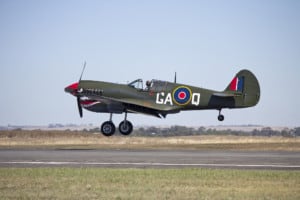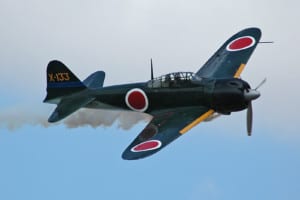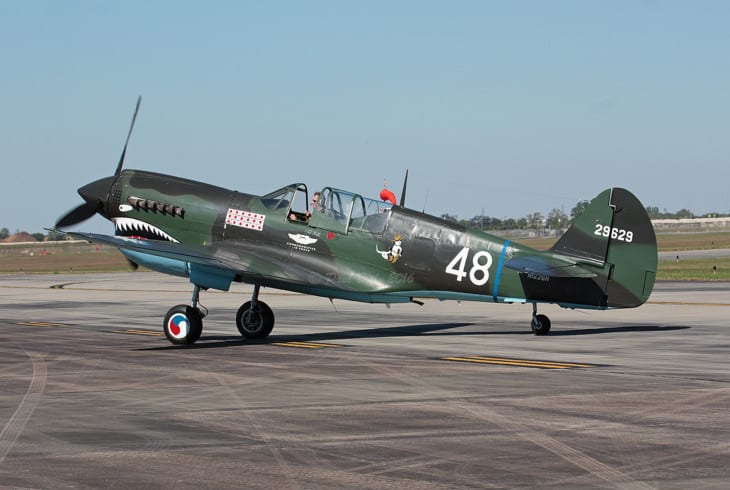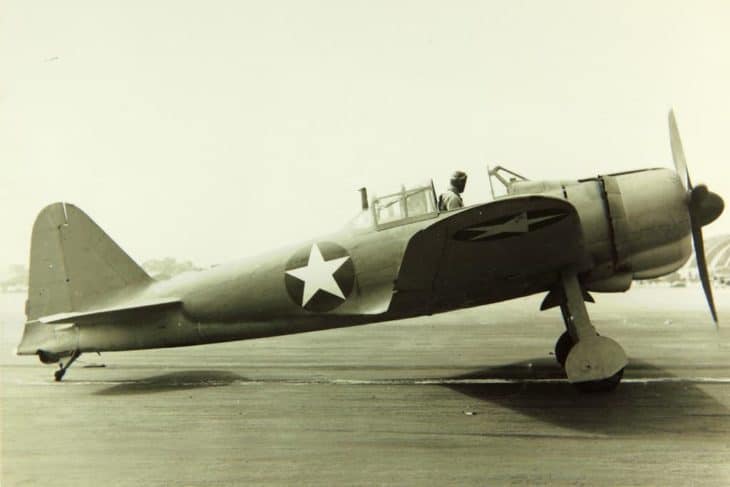The P-40 Warhawk was one of World War II’s iconic American fighter planes. It was rugged, reliable, and packed with a powerful punch, but it wasn’t the only fighter plane in the skies during the war. Its main adversary was the Japanese Zero. So, how did P-40 Warhawk vs Zero stack up against each other? Let’s take a closer look.
| Aircraft: | Curtiss P-40 Warhawk | Mitsubishi A6M Zero |
|---|---|---|
| Photo: |
 |
 |
| Country: | United States | Japan |
| Manufactured: | from: 1939 to: 1944 | from: 1939 to: 1945 |
| ICAO: | P40 | A6M |
| Price: | $0.045 million | $ million |
| Avionics: | - | - |
| Engine: | 1x Allison V-1710-39 | 1x Mitsubishi NK1F Sakae 21 |
| Engine Type: | Piston | Piston |
| Power: | 1,240 horsepower | 1,130 horsepower |
| Max Cruise Speed: |
318 knots 589 Km/h |
288 knots 533 Km/h |
| Approach Speed (Vref): | 83 knots | 60 knots |
| Travel Range: |
622 Nautical Miles
1,152 Kilometers |
1,010 Nautical Miles
1,871 Kilometers |
| Fuel Economy: | - | - |
| Service Ceiling: | 29,000 feet | 33,000 feet |
| Rate of Climb: |
2100 feet / minute 10.67metre / second |
3090 feet / minute 15.70metre / second |
| Take Off Distance: | - | - |
| Landing Distance: | - | - |
| Max Take Off Weight: |
4,173 Kg 9,200 lbs |
2,796 Kg 6,164 lbs |
| Max Landing Weight: |
3,862 Kg 8,514 lbs |
- |
| Max Payload: |
910 Kg 2,006 lbs |
270 Kg 595 lbs |
| Fuel Tank Capacity: |
157 gallon 594 litre |
224 gallon 848 litre |
| Baggage Volume: | - | - |
| Seats - Economy: | 1 seats | 1 seats |
| Seats - Business Class: | - | - |
| Seats - First Class: | - | - |
| Cabin Height: | - | - |
| Cabin Width: | - | - |
| Cabin Length: | - | - |
| Exterior Length: |
10.15 metre 33.30 feet |
9.06 metre 29.72 feet |
| Tail Height: | 3.77 metre - 12.37 feet | 3.05 metre - 10.01 feet |
| Fuselage Diameter: |
1 metre 3.28 feet |
1.1 metre 3.61 feet |
| Wing Span / Rotor Diameter: |
11.36 metre 37.27 feet |
12 metre 39.37 feet |
| Wing Tips: | No Winglets | No Winglets |
| More Info: | Curtiss P-40 Warhawk | Mitsubishi A6M Zero |
|
Data presented is for entertainment purposes and should not be used operationally.
|
Other Curtiss P-40 Warhawk comparisons:
Other Mitsubishi A6M Zero comparisons:
The Curtiss P-40 Warhawk

The P-40 was powered by a 1,200-horsepower Allison V-1710 engine with a top speed of around 360 miles per hour. It was armed with six .50 caliber machine guns and could carry up to 1,000 pounds of bombs.
However, the P-40 did have some drawbacks. One was its small fuel tank, which limited its range. Another was its lack of armor plating. That made the P-40 susceptible to enemy fire, and many pilots were lost due to direct hits to their planes’ fuel tanks or engines.
Why was the P-40 Warhawk developed and built?
The P-40 Warhawk was designed by Curtiss Aeroplane and Motor Company in 1938. The plane was built to be a rugged and reliable workhorse that could take much punishment and keep flying. And it certainly lived up to that reputation.
What purpose did the P-40 Warhawk serve?
The P-40 saw action in nearly every theater of World War II, from North Africa and the Mediterranean to the China-Burma-India Theater. Its biggest strength was its maneuverability.
Its wide stance allows it to make tight turns without losing speed or altitude. That made it a tough opponent for the Japanese Zero, which had difficulty matching the P-40’s agility.
The Mitsubishi A6M Zero

The Zero was powered by a 1,130 horsepower Nakajima Sakae radial engine with a top speed of around 350 miles per hour. It was armed with two 7.7 mm machine guns and could carry up to 500 pounds of bombs.
The Zero could stay in the air for hours thanks to its large fuel tank. That gave it a big advantage over the P-40, which often had to turn back before reaching its target due to lack of fuel.
However, like the P-40, the Zero did have some drawbacks. One was its light armament; despite being armed with twice as many machine guns as the P-40, the Japanese fighter still lagged behind its American counterpart in terms of firepower.
Why was the A6M Zero developed and built?
In 1937, the Mitsubishi A6M Zero was the fighter aircraft of the Imperial Japanese Navy. It was considered one of the most capable carrier-based aircraft in the world and was used in almost all combat operations by the IJN during World War II.
However, it had one major flaw: its fuel tank was located behind the cockpit, which made it highly susceptible to fires caused by enemy gunfire. To improve upon this design flaw, Mitsubishi developed the Zero Model 21, which featured a fuel tank in front of the cockpit.
What purpose did the A6M Zero serve?
Zero was lightweight; at just 4,700 pounds empty, it was nearly 1,000 pounds lighter than the P-40 Warhawk. That made it much more agile than its American counterpart—an important advantage in air combat. It was largely relegated to a ground attack role in the war’s later stages.
How are the P-40 Warhawk and A6M Zero different?
How do the World War II era Mitsubishi A6M Zero and Curtiss P-40 Warhawk compare? In terms of armament, both planes were armed with six .50 caliber machine guns.
But the Zero’s guns were mounted in wing root fairings and thus had a narrower firing convergence than the P-40’s guns, which were mounted in the cowling. This gave the P-40 a disadvantage in dogfights at close range. Moreover:
- The Zero had a much longer range than the P-40 due to its lighter weight and more fuel-efficient engine.
- The P-40, however, was much more rugged and dependable thanks to its heavier construction.
- It could take much more damage and keep flying, whereas the Zero was much more fragile.
How are the P-40 and Zero similar?
Although they differed significantly in design, both aircraft were known for their speed and maneuverability, making them formidable foes on the battlefront. And while these planes may seem like completely different machines from one another, they have some key similarities.
For example, both planes were constructed from lightweight materials, making them excellent for operations at high altitudes. Additionally, both utilized powerful engines, enabling them to reach high speeds easily.
Overall, the P-40 Warhawk and the Zero are shining examples of how two seemingly different types of fighters could be fundamentally similar in their basic design principles and capabilities.
What’s better about the P-40 Warhawk?
There’s no denying that the P-40 Warhawk was one of the most important aircraft of World War II. But what made the P-40 Warhawk so successful?
- P-40 Warhawk was adamant, so it could take a beating and keep going.
- Second, it was highly maneuverable for its time.
- Third, it was armed to the teeth with six .50-caliber machine guns.
- And last but not least, it could reach speeds up to 350 mph.
In the end, it all comes down to results. And when you compare the results, it’s clear that this is an aircraft that truly is in a league of its own.
What’s better about the Zero?
The Zero was incredibly lightweight, so it could make tight turns without losing speed or altitude.
- It was a formidable opponent for the P-40 Warhawk, which often had to turn back before reaching its target due to lack of fuel.
- Second, the Zero had a much longer range than the P-40 Warhawk so that it could stay in the air for hours.
- And last but not least, the Zero was armed with two 7.77.7 mmmm machine guns and could carry up to 500 pounds of bombs.
P-40 Warhawk vs Zero: Who’s The Winner?
Both planes had their share of advantages and disadvantages when pitted against each other in combat. In terms of sheer numbers produced, there is no doubt that the P-40 emerged victorious. In truth, there is no clear winner when comparing these two planes.
- The P-40 had better maneuverability but less range.
- The Zero had better range but less maneuverability.
Over 14000 P-40s were built during World War II, compared to just 1200 Zeros. But in terms of wartime effectiveness, both planes played an essential role in their respective countries’ efforts during World War II. Do you know what was like in 1920s air travel?
Conclusion
In conclusion, both planes contributed to their countries’ war efforts during WWII. The P- 40 Warhawk emerged victorious in terms o sheer numbers produced, but this story is different when you compare wartime effectiveness.
When pitted against each other in air combat, both planes had their fair share o advantages and disadvantages. So there is no clear winner when comparing these two aircraft.


